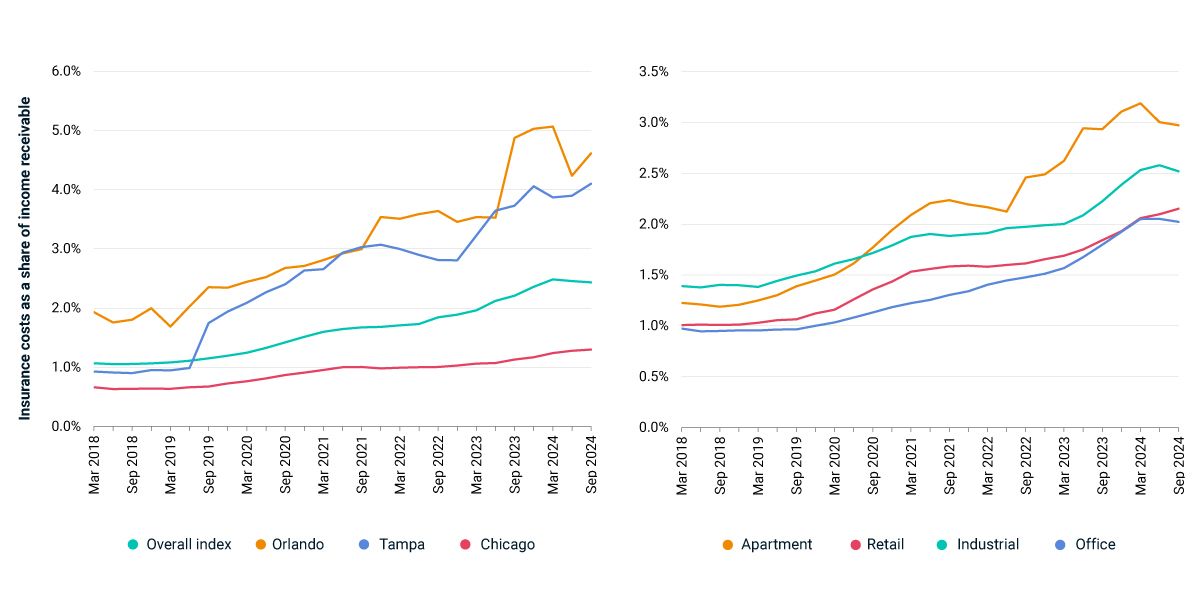Insurance Has Bigger Bite of Commercial-Property Income
In the complex landscape of rising property-insurance costs, numerous factors come into play, the most prominent of which is the increased frequency and severity of extreme weather events due to climate change.1 Asset managers individually will be aware of their increased insurance premiums pushing up operating costs and cutting into net operating income. And it's clearly visible at the benchmark level: for properties tracked by the MSCI U.S. Quarterly Property Index, insurance costs as a share of income receivable have doubled over the last five years, reaching 2.4% in the 12 months through Q3 2024.
There are disparities between regions, and not all the differences should be ascribed to climate-change pressures — for instance, regulations and rebuilding costs are also factors. Still, Orlando and Tampa, metros vulnerable to hurricanes, face some of the highest insurance costs relative to income, at 4.6% and 4.1%, respectively. In contrast, Chicago, a market with lower physical-climate-change risk exposure, has one of the lowest rates among U.S. metros, at 1.3%.2 Across property types, the apartment market has registered the sharpest increase in insurance costs over the past five years, rising to 3.0% of income from 1.4% five years ago.
The impacts of hurricanes Milton and Helene in late September and early October underscored the risk to commercial property and the pressures on the insurance industry. Rising insurance premiums will compel investors to reassess their underwriting assumptions and adopt strategies to mitigate escalating insurance expenses.
The author thanks Bryan Reid for his contributions to this quick take.
Overall insurance cost as share of income has doubled in five years

Selected metros. Source: MSCI U.S. Quarterly Property Index
Subscribe todayto have insights delivered to your inbox.
Flooding’s Rising Threat to Real Estate
Given real-estate assets’ increasing exposure to coastal, fluvial and pluvial flooding, it’s essential to understand the potential asset- and portfolio-level impacts of all three types. We analyze the exposure of more than 50,000 property assets.
Double Trouble: Exposing the Risks of Hurricanes Helene and Milton
Historic estimated losses from two recent hurricanes highlight the importance of understanding asset locations that face intensifying climate impacts.
Property Climate Risk Varied Across — and Within — Markets
When considering climate value-at-risk for real estate portfolios and assessing prospective investments, location and topography need to be understood at the individual asset level — not just the market level.
1 “Climate change impacts elevate US commercial real estate insurance costs,” Deloitte, May 29, 2024.\xa02 In MSCI’s real estate Climate Value-at-Risk (VaR) model, under a 3°C | REMIND | Current Policies scenario to 2050 with aggressive outcomes, Chicago scores an aggregated physical VaR of -0.1% compared to Tampa at -3.0% and Orlando at -2.1%.
The content of this page is for informational purposes only and is intended for institutional professionals with the analytical resources and tools necessary to interpret any performance information. Nothing herein is intended to recommend any product, tool or service. For all references to laws, rules or regulations, please note that the information is provided “as is” and does not constitute legal advice or any binding interpretation. Any approach to comply with regulatory or policy initiatives should be discussed with your own legal counsel and/or the relevant competent authority, as needed.
